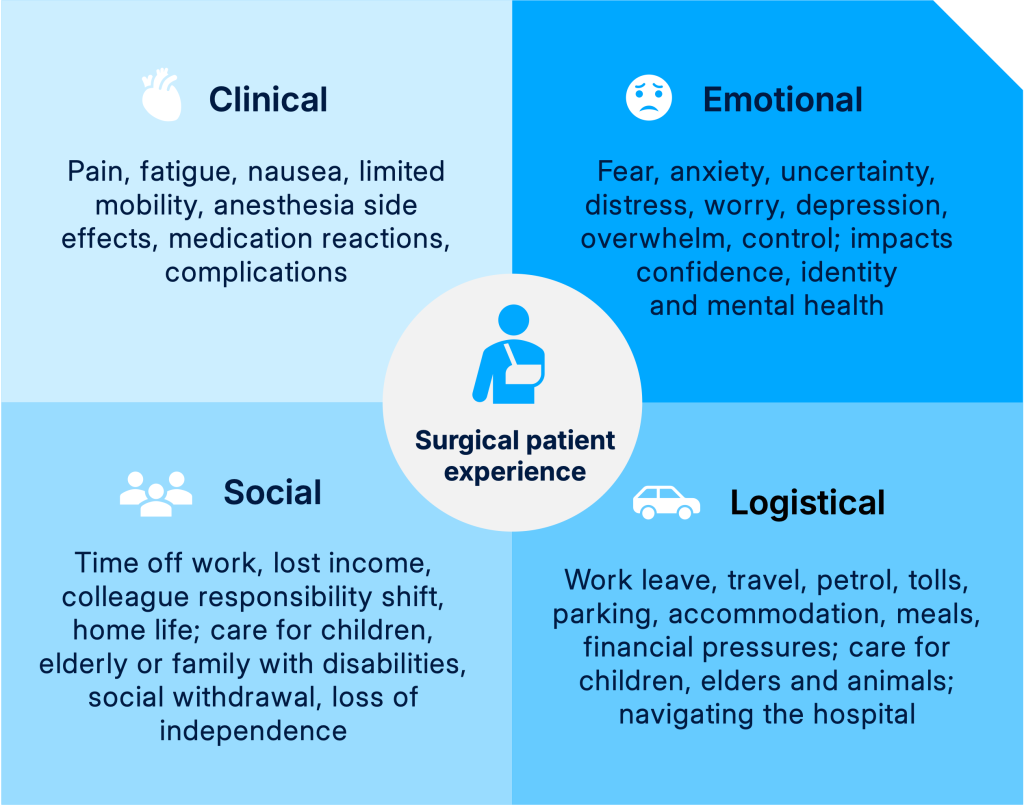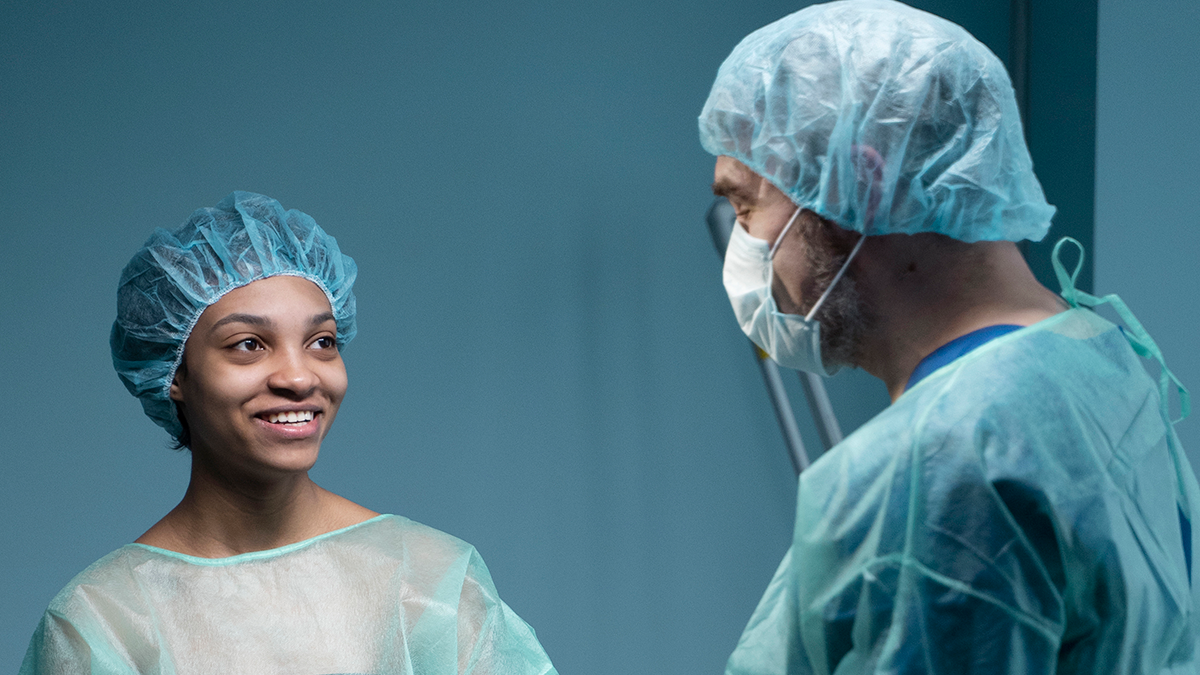If you want to understand how complex surgery really is, listen to the stories of patients from remote communities. I still think of the accounts shared by a rural nurse navigator, describing people from Far North Queensland who needed to make the long journey to Brisbane for surgery. Their travel alone was a feat of endurance: two boat rides, then two flights south – all coordinated by a determined team of healthcare workers. But some patients would arrive to crushing news: their surgery couldn’t go ahead for another six weeks because they hadn’t stopped their medication. This type of story isn’t uncommon, due to the complexities of being a surgical patient.
At first glance, the surgical journey might seem simple. A patient receives a diagnosis, prepares for a procedure, has surgery, recovers, and moves on. This tidy, linear view is typical in busy clinical environments.
But for the person in the hospital bed, surgery is anything but simple.
Behind every procedure is a complex web of experiences – physical, emotional, logistical and social – all happening at once. Beyond what’s happening physically, patients are juggling appointments, transport, finances, work and family. Roles change, identity shifts, pressures converge.
These journeys are complex and often not acknowledged within standard care models in healthcare organisations. To deliver truly person-centred care, we must see beyond the incision. Surgery may be measured in minutes, but its impact echoes across a patient’s whole life.
What Patients Really Experience in Hospitals

1. The Clinical Journey: The Burdens Patients Carry
A patient’s surgical journey often starts with uncertainty. Many spend weeks, months or even years, waiting to see a specialist, stuck in what feels like a hidden waitlist before they’re even officially on the surgical waitlist.
But life doesn’t stop during this time. Patients are in limbo, dealing with symptoms including pain, fatigue, nausea, limited mobility – while trying to work, parent and generally keep the wheels on.
Patients often say they feel in the dark during this period.
They don’t understand where they’re up to in the process, or what lies ahead.
Communication only happens in face-to-face appointments, with long gaps in-between and no easy way to get ongoing support or ask questions.
Information is often dense with medical jargon and delivered under stress. Have you ever come out of an appointment and feel like you can’t remember what was said? This is very common, and it makes information hard to absorb or act on.
Once in hospital, there are new challenges: side effects from anaesthesia, reactions to medications, complications. For many, the end of hospital care doesn’t mean the end of the journey. There are follow-up appointments, lifestyle changes, and long-term health impacts to manage. At this point, the journey typically feels open-ended.
2. The Emotional Journey: An Invisible Layer of Suffering
The physical side of surgery is just one part of the story. The emotional toll can be just as heavy, yet often goes unspoken.
Fear and anxiety are common in the lead-up to surgery. Sometimes it’s about the risks: pain, complications, or going under anaesthetic. But often, it’s the uncertainty that causes the most distress.
- How long will it take to recover?
- Will life go back to normal?
- What even happens next?
When patients don’t know what to expect, worry takes over. Some patients experience depression, especially if surgery delays major life plans or strips away their sense of control.
Past healthcare trauma can resurface, turning routine procedures into emotionally charged events. The flood of medical information doesn’t help either. Patients are asked to make serious decisions, often without the time or support to fully understand their options.
And for many, surgery changes how they see themselves.
Scars, fatigue, or longer-than-expected recoveries can impact confidence, identity, and mental health in ways that linger long after discharge.
3. The Logistical Journey: More Than Just Showing Up
Behind every clinical milestone is a logistical juggling act that health systems often underestimate, but patients live every day.
Getting surgical care isn’t as simple as just showing up.
It can mean taking leave from work, travelling hours, finding accommodation, or organising care for children, elders and animals. Not to mention navigating unfamiliar hospital environments. It can take a village just to get to a single appointment.
And when that appointment or surgery is cancelled or rescheduled at the last minute?
This adds more strain.
Petrol. Parking. Childcare. Tolls. Meals. These aren’t small extras: they’re real costs that add up fast, and they’re usually shouldered entirely by the patient and their family. For those already under financial pressure, the burden can be too much, delaying or deterring care altogether.
For those who do make it to hospital, the experience can be overwhelming, especially for older patients, those with language barriers, or first-timers.
Logistics aren’t just an inconvenience – they are often a hidden barrier to receiving care all together. And the more complex the care, the harder it gets.
4. The Social Journey: When Surgery Disrupts Life Roles
Surgery doesn’t just impact the body: it affects every part of a person’s life, like a ripple effect.
Time off work can mean lost income, especially for people without paid leave or stable jobs. It can also shift responsibilities onto colleagues, creating tension in already stretched teams.
At home, things may be even more complicated.
Patients may suddenly be unable to care for children, elderly parents, or family members with disabilities. That care doesn’t disappear – someone else has to step in, often with little notice or support. Even in close families, this can lead to stress, miscommunication, or emotional strain.
Social withdrawal is common. Patients are exhausted, embarrassed by what they can’t do, shaken by losing independence. Many stop reaching out altogether, not because they don’t care, but because they feel like a burden.

How This Impacts Healthcare Organisations
When we focus only on the procedure and overlook the person, everyone pays the price.
Emotional distress, logistical hurdles, and social strain aren’t just hard on patients, they lead to missed appointments, cancellations, readmissions, and poor treatment follow-through. These in turn directly impact operational flow, resource use, and clinical outcomes. The fallout is something most of us are familiar with: financial strain on the healthcare system and low staff morale.
What's Needed: A System Built Around the Whole Patient
To support people through surgery in a meaningful way, we must shift from fragmented, process-driven models to truly support the whole person.
This means designing care that anticipates, not just reacts to, the challenges patients face. It means embedding support across all four journeys: clinical, emotional, logistical, and social.
At the heart of this shift is empowerment through knowledge.
Too often, surgical patients feel like passengers on a journey they don't fully understand.
When we give patients the right information – clearly, at the right time, and in a format they can absorb – we build confidence, improve preparation, create autonomy, and improve outcomes.
Digital Health: Patient Experience Technology Turning Complexity into Clarity
The importance of seamless experiences in the healthcare industry cannot be understated. Digital health solutions bring visibility, coordination and continuity in ways that traditional systems simply can’t. They support every stage of the surgical journey, making care feel more connected, more personalised, and less overwhelming.
Done right, they help patients arrive ready and informed.
To do this effectively, we need to take a holistic view of the patient’s journey. Not just sending them appointment reminders and digital forms, but also considering:
- Personalised education and health optimisation plans
- Logistical information, such as how to get to and around the hospital
- Social and emotional support, such as how to access travel and accommodation subsidies, psychologists, social workers and other supports – along with self-help resources such as mindfulness
- Allowing a patient’s loved ones a level of access to their care information where appropriate
- Ensuring that digital health tools help to set patient expectations and explain processes
- Ensuring there are feedback tools in place and 2-way messaging so patients can ask questions in their own time
Digital health engagement platforms should give patients agency, turning what can feel like a confusing, isolating journey into one that is clear, guided, and centred on the person. Through this, the healthcare industry will be able to achieve patient satisfaction with less room for error.
Moving Towards Better Patient-Centred Care
Improving surgical care isn’t just about doing what we already do, but faster or more efficiently. It’s about truly understanding what the surgical journey feels like for the patient.
When we recognise the clinical, emotional, logistical, and social realities people face, we can design systems that work better, not just for the health system, but for the people in it.
Digital patient engagement solutions aren’t the whole answer. But when they’re implemented with purpose and empathy for positive patient outcomes, it becomes a powerful tool.
Most importantly, it helps us move toward a model of care that doesn’t just treat a condition, but also supports the person behind it.
Digital Health: Patient Engagement FAQ's
What is patient engagement software?
Patient engagement software refers to digital solutions that enable healthcare providers to communicate with, educate, and support patients throughout their healthcare journey. It helps improve outcomes and patient satisfaction by making healthcare more interactive and accessible.
How can we improve patients’ experience of healthcare?
Hospitals and healthcare organisations can improve patient experience by investing in patient-centred care models, using digital health engagement solutions, and providing clear communication at every stage of the surgical journey.
How do you use technology to enhance patient care?
Technology enhances patient care by simplifying communication, reducing logistical barriers, and providing tools such as smart forms, digital patient pathways, and two-way engagement platforms.
What is a digital care pathway?
A digital care pathway is a structured plan delivered through digital platforms that guides patients step by step through their healthcare journey, ensuring they receive timely information, support, and follow-up.
What are examples of patient experience?
Examples of patient experience include the ease of navigating hospital services and physical environments, the clarity of communication and information from healthcare providers, and how technology to improve patient experience reduces stress and uncertainty during treatment.



